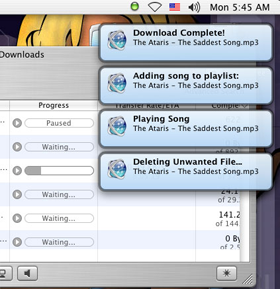Gears Future APIs: Notification API

The browser is a fantastic platform to develop applications on. The reach of the Web is unprecedented and the psychology of “installing an app” versus “going to a web page” is huge.
There are still desktop integration features such as desktop shortcuts that link the browser to the underlying host in a nicer way.
One of the missing links is between the browser and the system tray and notification system.
I want to see a Notification API Gear that allows you to tie this together.
Use Cases
Instead of having to install notification agents for applications that you use such as Gmail and Google Calendar, the notification can be built into the applications themselves. You upload a video to YouTube, and it will get back to you when it is done. You choose to “watch” a particular post on the Web? It tells you when there are updates. Google alerts on certain tags do the same.
I find that in my river there are a few occasions where I want to be interrupted (which notifications can do). Depending on your preferences these occasions may be “when my wife emails” or “when someone talks about some cool Ajax thing” or “when someone emails me directly” or “when someone @twitters me”. If I really want to know, I want a notification. If it is slightly less important, I want an email.
In fact, if it is TRULY important, I may even want a text message. This is where configurability comes in. Growl is an event notification for Mac OS X, and it nails all of this. It abstracts the applications from the user. I can go in and change the dials so I get notifications when I want them, how I want them (e.g. in my face, SMS, email), and what they look like (styling). This also includes being able to turn them off.
I want Growl for the Web. Applications can get permission to add events to a notification queue, and I the user can choose how to deal with those notifications.
The API
The API itself should be as simple as possible. This is pretty much a messaging pub/sub system, where the application can publish messages on a queue for its app, with different message types for the type of events.
var notifier = google.gears.factory.create('beta.notifier', '1.0'); notifier.notify({ application: "My App", title: 'warning', description: 'some text', priority: 2, sticky: 'True', password: 'Really Secure', });
Growl allows you to have actions in the message itself. That would mean allowing anchor links in the description in the Web world.
There is also the thought that you could also subscribe to various events from other applications, but that can get messy.
System Tray
This notification system could tie into the system tray, or that could be its own API. I worry about the proliferation of tray icons though :)
Beware
The big worry is that people will start spamming the notification system. This is a real concern, and needs to be seriously considered from the beginning. The balance will be in how much we ask users to do, without asking too much so no notifications ever get turned on. With a growl like system it will be easy to turn on and off notifications per application.
What do you think? Is this a useful API?
Other Future APIs
- Crypto API
- Developer Tools
- Factory API updates
- Blob API
- Logging API
- Messaging API
- Location API
- Desktop Shortcut API
- Image Manipulation API
- Introduction to the series
Disclaimer: This is me rambling about APIs and tools that I would love to see in Gears, or the Open Web as a whole. Do you have ideas for cool Gears that make the Web better? Let us know!.


